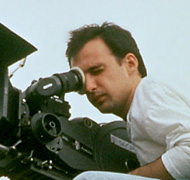America/Canada
---David Cronenberg
---George Romero
---Guillermo del Toro
---Sam Raimi
---Stuart Gordon
Europe
---Alejandro Amenabar
---Dario Argento
---Lucio Fulci
---Mario Bava
---Michele Soavi
---Jean Rollin
Britain
-1965-1970
-1971-1976
---Clive Barker
Asia
-1996-2002
---Hideo Nakata
---Toshiharu Ikeda
Links
---DVD's / Videos
---DVD Reviews
---Upcoming DVD's
---Books
 Artisan Entertainment, 1997 |
" . . . . having taken the mysterious videocassette home with her, Angela summons up the nerve to watch it, but at the last minute, fearing what she'll see, she decides to play the video with sound only. Nervously she listens. She hears . . . a woman sobbing . . . crying . . . whimpering . . . begging . . . screaming . . . SCREAMING . . . then a brief silence, one that is shattered by the sound of a chainsaw starting up" -- - "Thesis", Fangoria 174, 1998 by Mike Hodges |
| Date | Title | Source | IMDB | DVD Reviews |
| 1996 | Tesis/Thesis | DVD | IMDB | A D F |
| 1997 | Abre los ojos/Open Your Eyes | DVD | IMDB | C H |
| 2001 | The Others | DVD | IMDB | A C E F |
|
For a complete filmography go to the IMDB
Born in Santiago de Chile in 1972, Amenabar was barely a year old when Pinochet's military takeover forced his Chilean father and Spanish mother to flee to Madrid, where his family has lived ever since. "We got out just 2 weeks before the coup," Amenabar recalls. Like most of today's movie directors, Amenabar started his career when he got hold of a video camera. His first video short was THE HEAD (1992) - a thriller with an over the top, gory ending where the protagionist rips a guys head off and the head bounces around the floor. A couple of years later, while he was studying information sciences at Madrid University, one of his short movies came to the attention of Spanish film director/producer Jose Luis Cuerda, who asked Amenabar to write a feature film script for him. The result was the first draft of THESIS, which Cuerda read and immediately decided to put into production. Amenabar suddenly found himself, at only 23, with $1 million and five and a half weeks with which to make a succesful commercial movie. The end result is a genuinely scary and suspenseful thriller in the Hitchcock tradition, one that also addresses censorship and how modern media uses images of extreme violence as just another weapon in the ratings war. THESIS tells the story of university student Angela, who is researching her thesis on violence in the media. One of her tutors, who has promised to find suitable audiovisual material from the campus archive, accidently discovers a network of disused storerooms in the basement. He finds an unmarked videocassette and puts it into a VCR, but is murdered before he gets a chance to divulge the tape's content. Angela finds the cassette and decides to watch it, seeking a clue to the murderers identity, and in doing so discovers that snuff movies are being made in the universit's basements. Inevitably, she's soon cast as the next victim, and so begins a nail-biting game of cat and mouse between Angela and the chief suspect. THESIS was a huge box-office success in Spain, and won seven Goya awards (the Spanish Oscar equivalent) as well as picking up prizes at a number of international festivals. Shooting a successful follow-up to such an impressive debut was a tall order, but Amenabar pulled it off in style with the nightmarish OPEN YOUR EYES, which debuted to even greater critical acclaim and surpassed the grosses of Thesis. The film opens in a state prison psychiatric cell, where a hunched figure wearing a grotesque flesh textured mask is being interviewed by a psychoanalyst. This is the starting point of the labyrinthe plot, involving a twentysomething playboy, his bestfriends girl and a mysterious, disturbed woman infatuated with him. A car crash leaves him disfigured, and unable to restore his good looks he slowly descends into madness.
Although OPEN YOUR EYES sounds like an old fashioned psycho-thriller, the power of Amenabars vision lies in the story's complexity and deftness with which he weaves apparently disparate, incomprehensible threads into a compelling and surprising tapestry of suspense, weird passions, horror and . . . more. Amenabar uses his camera to evoke dreams that are reality and realities that turn out to be hallucinations, to conjur up sensations of deja vu, to visualise dreams within flashbacks and flashbacks within dreams." |